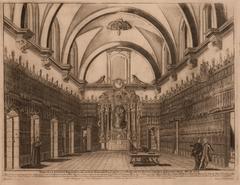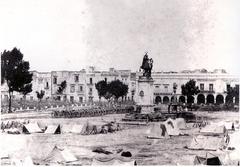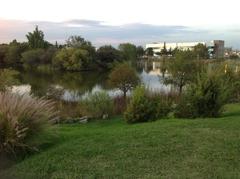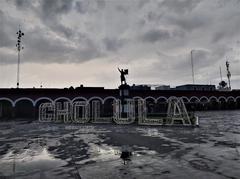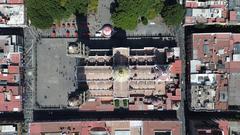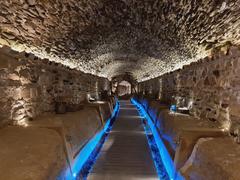Visiting Avenida 3 Oriente, Puebla, Mexico: A Complete Guide
Date: 18/07/2024
Introduction
Avenida 3 Oriente, nestled in the vibrant heart of Puebla, Mexico, is a thoroughfare that seamlessly blends historical grandeur with contemporary charm. Founded in 1531 by Spanish settlers, Puebla was strategically located as a midpoint between the port of Veracruz and Mexico City, with Avenida 3 Oriente being a crucial part of its original grid layout designed to facilitate trade and governance (Puebla History). Today, this avenue stands as a testament to Puebla’s rich colonial heritage, showcasing an array of Baroque architecture, religious landmarks, and bustling marketplaces. Visitors can marvel at the intricate stucco work of the Casa del Alfeñique, delve into the artistic heritage at the Regional Museum of Puebla, and explore significant religious sites like the Church of San Francisco (Casa del Alfeñique, Church of San Francisco). Avenida 3 Oriente has not only retained its historical essence but has also evolved into a cultural hub, hosting festivals and events that celebrate Puebla’s vibrant traditions (Cinco de Mayo). This guide aims to provide a comprehensive overview of Avenida 3 Oriente, offering insights into its historical significance, visitor tips, and cultural highlights, ensuring a memorable experience for anyone exploring this iconic avenue.
Table of Contents
Historical Background
Colonial Origins
Founded in 1531 by Spanish settlers, Puebla was strategically established to serve as a midway point between the port of Veracruz and Mexico City. Avenida 3 Oriente, one of the city’s principal thoroughfares, played a crucial role in the urban planning and development of Puebla. The avenue was part of the original grid layout designed by the Spanish, which was intended to facilitate trade and governance (Puebla History).
Architectural Significance
The architecture along Avenida 3 Oriente is a testament to the city’s colonial past. Many of the buildings feature the distinctive Baroque style that was prevalent during the 17th and 18th centuries. Notable structures include the Casa del Alfeñique, a stunning example of Baroque architecture adorned with intricate stucco work. This building now houses the Regional Museum of Puebla, offering visitors a glimpse into the city’s artistic and cultural heritage (Casa del Alfeñique).
Religious Influence
Religion played a significant role in the development of Avenida 3 Oriente. The avenue is home to several important religious sites, including the Church of San Cristóbal and the Church of San Francisco. These churches were not only places of worship but also centers of social and cultural life in colonial Puebla. The Church of San Francisco, in particular, is renowned for its beautiful façade and the adjacent convent, which was one of the first Franciscan establishments in the region (Church of San Francisco).
Economic Hub
During the colonial period, Avenida 3 Oriente emerged as a vital economic hub. The avenue was lined with shops, markets, and workshops, making it a bustling center of commerce. The proximity to the Zócalo, Puebla’s main square, further enhanced its economic significance. Merchants and artisans from various parts of the region would converge here to trade goods, contributing to the avenue’s vibrant atmosphere (Puebla Commerce).
Independence and Reform
The 19th century brought significant changes to Avenida 3 Oriente as Mexico underwent its struggle for independence and subsequent reforms. The avenue witnessed numerous historical events, including the passage of revolutionary troops and the implementation of liberal reforms aimed at modernizing the country. These reforms included the secularization of church properties, which had a profound impact on the religious institutions along the avenue (Mexican Independence).
20th Century Developments
The 20th century saw further transformations along Avenida 3 Oriente. The Mexican Revolution (1910-1920) and subsequent political changes led to urban modernization efforts. The avenue was widened, and new infrastructure was introduced to accommodate the growing population and increasing traffic. Despite these changes, Avenida 3 Oriente managed to retain much of its historical charm, with many colonial-era buildings preserved and restored (Mexican Revolution).
Cultural Renaissance
In recent decades, Avenida 3 Oriente has experienced a cultural renaissance. The avenue has become a focal point for cultural activities, including festivals, parades, and art exhibitions. The annual Cinco de Mayo celebrations, commemorating the Battle of Puebla, are particularly noteworthy. These events attract both locals and tourists, highlighting the avenue’s enduring cultural significance (Cinco de Mayo).
Preservation Efforts
Efforts to preserve the historical and architectural heritage of Avenida 3 Oriente have been ongoing. The avenue is part of Puebla’s historic center, which was designated a UNESCO World Heritage Site in 1987. This designation has helped to protect the avenue’s unique character and ensure that any development is carried out in a manner that respects its historical significance (UNESCO World Heritage).
Visitor Information
Visiting Hours and Tickets
Most of the historical sites along Avenida 3 Oriente, including museums and churches, have specific visiting hours. It is advisable to check the official websites for the most up-to-date information on opening hours and ticket prices. For instance, the Casa del Alfeñique is open from 10 AM to 5 PM, Tuesday to Sunday, with a modest entrance fee.
Travel Tips
- Best Time to Visit: The best time to explore Avenida 3 Oriente is during the dry season, from November to April. The weather is pleasant, making it ideal for walking tours.
- Guided Tours: Consider joining a guided tour to gain deeper insights into the historical and cultural significance of the avenue. Many local tour operators offer specialized tours focusing on the colonial architecture and religious history of the area.
- Photography Spots: Don’t miss the chance to capture the stunning Baroque architecture. The façade of the Church of San Francisco and the intricate details of Casa del Alfeñique are particularly photogenic.
- Local Cuisine: Enjoy the local cuisine at the many cafes and restaurants lining the avenue. Traditional dishes like mole poblano and chiles en nogada are must-tries.
Nearby Attractions
- Zócalo: Just a short walk from Avenida 3 Oriente, Puebla’s main square is a hub of activity and home to the impressive Puebla Cathedral.
- Biblioteca Palafoxiana: The first public library in the Americas, located a few blocks away, is a must-visit for book lovers and history enthusiasts.
- Amparo Museum: This museum offers a comprehensive overview of Mexican art and history, situated conveniently close to Avenida 3 Oriente.
FAQ Section
What are the visiting hours for Avenida 3 Oriente?
Most historical sites along Avenida 3 Oriente are open from 10 AM to 5 PM, Tuesday to Sunday. It’s best to check specific sites for their official hours.
Are there any entrance fees?
Yes, some sites like museums may charge a modest entrance fee. For example, the Casa del Alfeñique has an entrance fee.
What is the best time to visit?
The best time to visit is during the dry season, from November to April, when the weather is pleasant for walking tours.
Are there guided tours available?
Yes, there are several guided tours available that offer deeper insights into the historical and cultural significance of Avenida 3 Oriente.
What are some nearby attractions?
Nearby attractions include the Zócalo, Biblioteca Palafoxiana, and the Amparo Museum.
Conclusion
Avenida 3 Oriente’s historical background is a tapestry of colonial architecture, religious significance, economic vitality, and cultural renaissance. Its preservation as part of Puebla’s UNESCO World Heritage Site ensures that future generations can continue to appreciate its rich heritage. Whether you’re a history enthusiast, an architecture aficionado, or simply a curious traveler, Avenida 3 Oriente offers a unique and enriching experience that captures the essence of Puebla’s storied past. For more updates and travel tips, download our mobile app Audiala or follow us on social media. Happy exploring!


